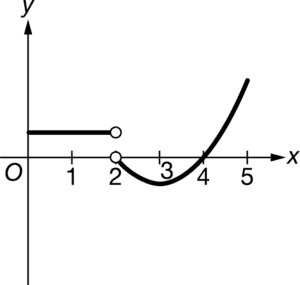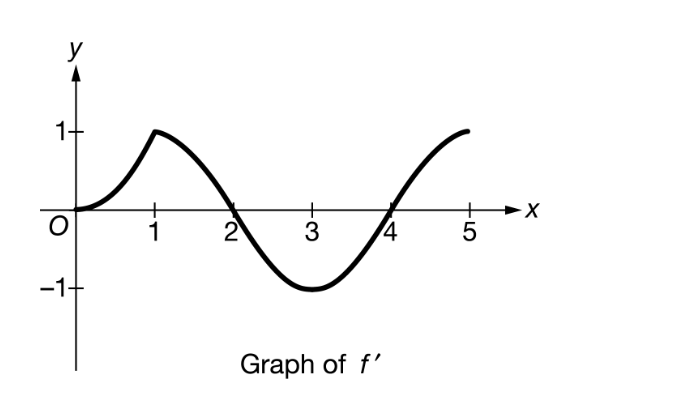Question

The function f is continuous on the closed interval [0,5]. The graph of f′, the derivative of f, is shown above. On which of the following intervals is f increasing?
A [0,1] and [2,4]
B [0,1] and [3,5]
C [0,1] and [4,5] only
D [0,2] and [4,5]
▶️Answer/Explanation
Ans:D
The function
is increasing on closed intervals where
is positive on the corresponding open intervals. The graph indicates that f′(x)>0 on the intervals
and
, so f
is increasing on the intervals
and
.
Question

The derivative g’ of a function g is continuous and has exactly two zeros. Selected values of g’ are given in the table above. If the domain of g is the set of all real numbers, then g is decreasing on which of the following intervals
A -2 ≤ x ≤ 2 only
B -1 ≤ x ≤ 1 only
C x ≥ -2
D x ≥ 2 only
E x ≤ -2 or x ≥ 2
▶️Answer/Explanation
Ans:A
Question

The function
is continuous on the closed interval [0,5]. The graph of f
, the derivative of
, is shown above. On which of the following intervals is f increasing?
and [2,4]
B [0,1] and [3,5]
C [0,1] and [4,5]only
D [0,2] and [4,5]
▶️Answer/Explanation
Ans:D
The function
is increasing on closed intervals where f
is positive on the corresponding open intervals. The graph indicates that f′(x)>0 on the intervals (0,2) and (4,5), so f
is increasing on the intervals [0,2] and [4,5].
Question
Let f be the function given by f(x)=3−2x. If g is a function with derivative given by g′(x)=f(x)f′(x)(x−3), on what intervals is g increasing?
A \((-\infty ,\frac{3}{2}]\) and \([3,\infty )\)
B \((-\infty ,\frac{3}{2}]\) only
C \([\frac{3}{2},3]\) only
D \([\frac{3}{2},\infty )\)
E \([3,\infty )\) only
▶️Answer/Explanation
Ans:A
